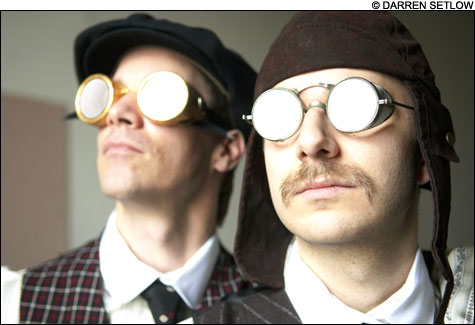
LEARNING TO FLY But in this version, the Wright brothers ain’t got wings. |
The set of Portland Stage Company's Center of Gravity is a spacious, elegant network of cables, a ladder, and a ramp. Aloft above it is a delicate flying machine of white wings and pale strips of wood. And downstage, at the very bottom of it all, there is a bed. On this set unfolds a story of the Wright brothers, but it's not your grandmother's story of the Wright brothers. Nor is it, for that matter, history's story of the Wright brothers.
Instead, playwright Gregory Hischak gives it the subtitle The Disinvention of the Airplane, and imagines an alternate narrative: Orville and Wilbur (Matt R. Harrington and Christopher Kelly) do not become the first men to fly. Instead, they struggle with the physics of their fraternal differences — "I possess lift; you have gravity," the exuberant Wilbur tells practical, stodgy Orville. While you need both lift and gravity to fly, in this team of brothers the contrasting qualities are more often conflicting than complementary, and on top of that, they're also in love with the same woman, a childhood friend and witty mathematician named Margot (Sophia Holman). Paul Mullins directs the cast of three visiting Equity actors plus Portland's own marvelous Maureen Butler, as Mother Wright, in this whimsical, beautifully produced show.
The story takes place in no one set time period, but rather with the drift of Orville's memory — their childhood in Dayton, Ohio; their early experiments and the famous trials at Kitty Hawk; and Orville's old age alone with Margot. The actors beautifully evoke memory's fluidity in their movements over the several levels of the set: They slip in and out of the boundaries of scenes; call out from high places, low places, and other times; and sometimes linger on the outskirts of scenes as quiet, watchful presences. As you might expect, much is made of verticality: The impossibly buoyant Wilbur is constantly rising up the ramp and ladder, while Orville's grounded presence pulls him back. Director Mullins's blocking conjures some lovely tableaux of all four Wrights arrayed at various levels of height, in beautiful suggestions of the dimensions and forces at play in their relationships.
Their characterizations likewise succeed in suggesting powerful but very different forces at work: Margot's love with Orville and is stable and solid, while she and Wilbur are electric. Harrington and Kelly easily place the two brothers at opposite ends of a spectrum, Kelly with his leaps and his joyful, near constant, slightly mad laugh; Harrington with his plodding gait and the fussy firmness of the set of his jaw. They also convincingly evoke the sort of sibling bond that nevertheless arises from such opposition.
As Margot, the creature who attracts and is attracted to both men, Holman is a great pleasure to watch. In her hands Margot's complexity is rich and sympathetic — her power over the men is mighty but doesn't feel manipulative; her secret relationship with Wilbur is both more and less than duplicity. She and Harrington are particularly good at slipping in and out of their aged characters, in conveying how their personalities translate over the force of time.